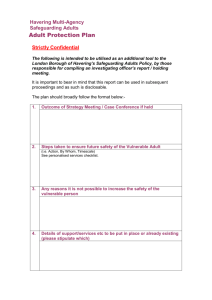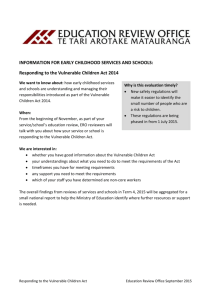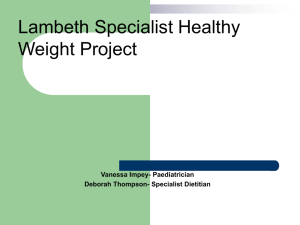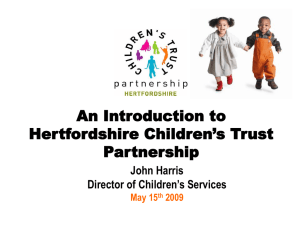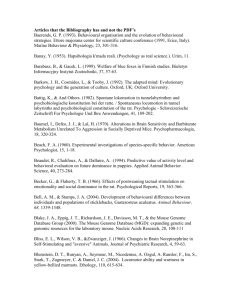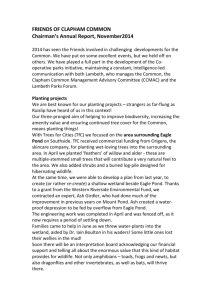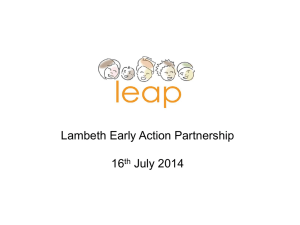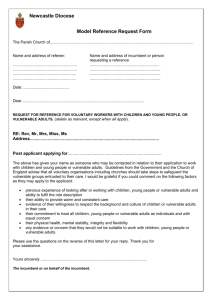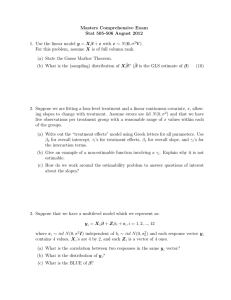Early Intervention Health Visiting
advertisement
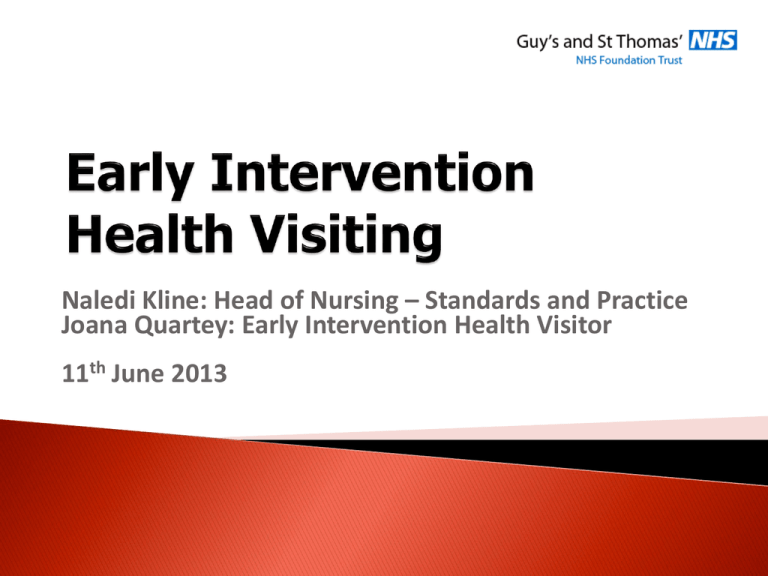
Naledi Kline: Head of Nursing – Standards and Practice Joana Quartey: Early Intervention Health Visitor 11th June 2013 Early contact: During pregnancy Targeted: Vulnerable pregnant women Service: Intensive work with women and their children Duration: Transfer to generic service between 13 – 24 months Health Visitors MAPPIM: St. Thomas’ Hospital Midwives: St. Thomas’ Hospital Children & Young People’s Service (Lambeth) Children’s Centres (Lambeth) Peri-natal Units: KCH & St. George’s Hospital Community Mental Health Services Family Nurse Partnership (Lambeth) GPs (Lambeth) Prevention of child abuse, safeguarding children by providing an early help service to support children and their families at the ‘softer’ end of child protection and safeguarding. Our overarching aim is to work with parents and their children to enable them to achieve their full potential Help & support to change behaviours, be the best they can as parents and meet their children’s physical, emotional mental and social needs. Achieved by all four main areas of working as per Health Visitor Implementation Plan (2011-15): i. Community Services ii. Universal Services iii. Universal Plus and iv. Universal Partnership Plus Services. Special Focus on: The Triple ‘P’ (Positive Parenting Programme), Sleep Clinics, Baby Massage, Home Safety, Infant Resuscitation & Postnatal Support Groups, Personal Ambition. Sleep Clinics: i. Gradual approach based on social learning theory ii. Families are supported to make small incremental changes Healthy Child Programme Hard to reach and vulnerable families from antenatal contact to 2nd birthday and throughout childhood within the universal teams’ caseload. Based on helping child development through managing their behaviour in a constructive and non-hurtful way by: i. Ensuring a safe and engaging environment ii. Creating a positive learning environment iii. Using assertive discipline iv. Focus on attachment v. Having realistic expectations vi. Taking care of themselves as parents Builds confident early access to all services Increased antenatal contact includes individual care planning, continuity into the postnatal period and first two years of life Increased breast feeding rates 100% uptake of Immunisations and Health Reviews Reduced A&E attendances Reduced rate of second pregnancies in teenagers Intensive, preventive approach ensures continuity of contact and improved working relationship Reduced risk of maternal mental illness Reduced risk of exiting mental illness worsening Increase potential for families to protect their children and themselves from risk of significant harm in the long term Cost effective as fewer failed appointments lead to effective use of staff time Negative associations with health visiting and other services Lack of confidence, self esteem and feeling powerless Language barriers Fear No recourse to public funds Asylum seekers/refuges High quality, integrated range of early intervention services to vulnerable children under two, their parents and carers Planning and managing caseloads Increased contact with children and families Safeguard and promote welfare of vulnerable children and families Identification and management of risk Effective partnership working across Children’s Centres Effective interagency partnership working Re-integration of teenagers and young parents to mainstream education Regular attendance of vulnerable families at short courses run at the Children’s Centres has led to increased self esteem and self confidence for the parent users. Ms S Watson and son J Watson Ms T Cox and daughter L Cox “ If you are thinking a year ahead, sow a seed. If you are thinking ten years ahead, plant a tree. If you are thinking a hundred years ahead. educate children.” Tzu, Chinese poet 500BC Thank you
